
Paul T. Thompson |
|
Ghost lights in my picture. What is the cause/fix?
|
|
|
|
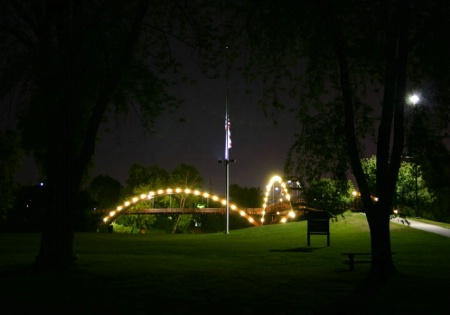
First Aberation
Paul T. Thompson
|
|
|
|
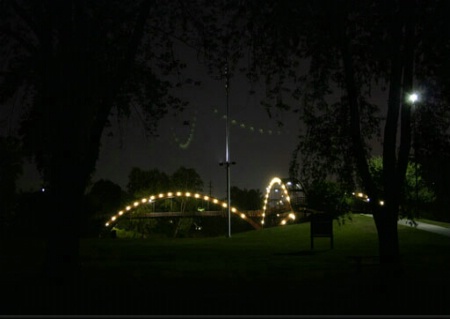
Second Aberation
Paul T. Thompson
|
|
|
|
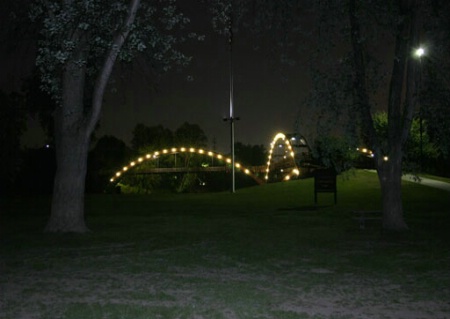
No Aberation
Paul T. Thompson
|
|
|
|
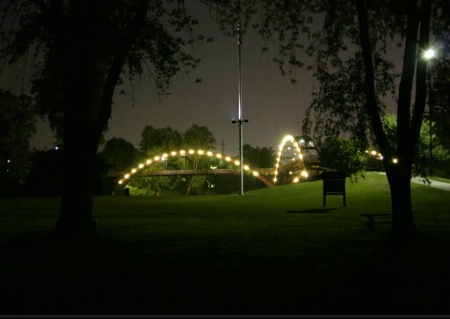
No Aberation here either
Paul T. Thompson
|
|
|
|
See examples. Getting an arc of reflections, reflected on both y and x axes. Shot with canon EOS Digital Rebel, RAW encoding:
11:31:16 PM
Shooting Mode Program AE
Tv 8
Av 4.0
Metering Mode Evaluative
Exposure Compensation +1
ISO Speed 400
Lens 18.0 - 55.0mm
Focal Length 27.0mm
Flash Off
White Balance Auto
AF Mode Manual Focus
Parameters
Contrast +1
Sharpness +1
Color saturation +1
I shot four pictures of this, varying exposure times and f/stops. The smaller the aperture, and longer the shutter speed, the more these ghost lights showed up. I went back and shot the same scene again, and got mixed results:
Tv 1.3
Av 4.5
Metering Mode Partial
Flash Off
White Balance Auto Produced the ghosting, however: Tv 1.3
Av 4.5
Metering Mode Center-weighted averaging
Flash On
Flash Type Built-In Flash
Flash Exposure Compensation 0
Red-eye Reduction Off
Shutter curtain sync 1st-curtain sync
White Balance Auto Resulted in no ghosting, and neither did: Tv 3.2
Av 4.5
Metering Mode Center-weighted averaging
Flash Off
White Balance Auto These settings were the same for all three re-takes: ISO 800
Lens 18.0 - 55.0mm
Focal Length 28.0mm
AF Mode AI Focus AF
plus, all parameters set to normal (using AdobeRGB color space)
Anyone have any idea what's going on here? Anyone know how to correct it?
August 02, 2004
|
|
|
Jon Close |
|
The ghosting comes from internal reflections in the lens and betweent the lens's rear element and the reflective digital sensor. Typical with inexpensive lenses and bright point light sources. Use of a lens hood may help somewhat. >>"The smaller the aperture, and longer the shutter speed, the more these ghost lights showed up."<< I think that is the key to avoiding it.
August 02, 2004
|
|
|
Paul T. Thompson |
|
That was my first impression too, but when we go back and look at the retakes, the one with the ghosts, and the one without (and without flash) were taken with exactly the same settings, differing only in that the one with no ghosting was shot at Tv 3.2, versus 1.3 for the shot with the ghosts. This is the oposite of what we would expect if longer exposure was truely responsible. The only other diference between the two shots was the metering mode: Partial for the shot with the ghosts, and Center-weighted averaging for the shot without. Note also that these two shots were taken less than a minute apart, and well after dark, so changing ambient lighting I think is not responsible (also, the other good retake, with the flash, was actually the first one chronologially). So this leads me to believe that the metering mode might be responsible, though how, I'm don't quite comprehend. Looking at the histograms of the two shots, the one with the ghosting had much higher levels on the dark end, where as the shot without ghosts had a bit more on the lighter end. I'm really not very familiar with histograms, so I'm not sure how to interpret this info. (Does anyone know how to extract histograms so I can post them here?) Anyway, does this spark any new ideas?
August 02, 2004
|
|
|
Jon Close |
|
The ghosting is purely a function internal reflections. That's what you need to remedy. The aperture setting will have some effect, as will the zoom setting and the angle from the specular light source(s). The ghosting is completely independent of shutter speed and metering mode.
August 02, 2004
|
|
|
Paul T. Thompson |
|
Ok. I think going and doing some more testing is in order.
August 02, 2004
|
|
|
Paul T. Thompson |
|
|
|

|
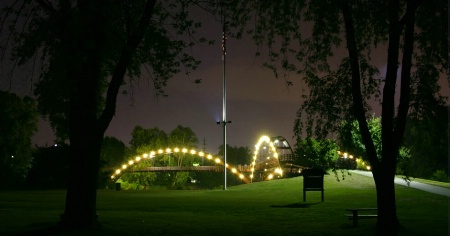
Flag at the Tridge
Taken with Canon EOS Digital Rebel, with EF-S 18-55mm Lense. focal length 18mm used to eliminate ghosting of the bridge lights which had been appearing.
Rather a long exposure, I think. Several seconds. Had to wait for a night without wind so the flag didn't blur
Paul T. Thompson
|
|
|
|
Alright then. I've neglected this for a while, but here's an update. Turns out, if you look very closely, all of the above pictures display the ghosting. I'm confident now in the explination given above. Furthur, and more importantly, I've figured out how to eliminate it: Since this is a zoom lense being used, all that is needed is to zoom out as far as possible. So I zoomed all the way out to 18mm and retook the shot. Here is the final product. Changing the distance between the sensor and the rear elements corrected the problem. I expect that this problem would not be likely to occur in larger lenses, where the rear element is further away from the detector. Note that in the EF-S series of lenses, this is actually a feature which is touted by Cannon. Buy carefully if they ever come out with more.
October 17, 2004
|
|
|
Becky M. Peters |
|
I do have a bit of a different explination. I have always been a bit of a ghost/spirit hunter and lately I have been hearing several stories about a young (15 yr. old) girl who is haunting the tridge and the trails behind the tridge. I know that spirits show up on film very well and I am now curious if she was attracted to your camera and is showing herself. I am not positive though because the image all looks exactly the same to me. I don't know but that might be a fun thing to look in to.
May 03, 2005
|
|
|
anonymous |
|
If you can't fix it, photoshop can! I wouldn't worry too much.
May 03, 2005
|
|
|
|
Log in to respond or ask your own question.
|